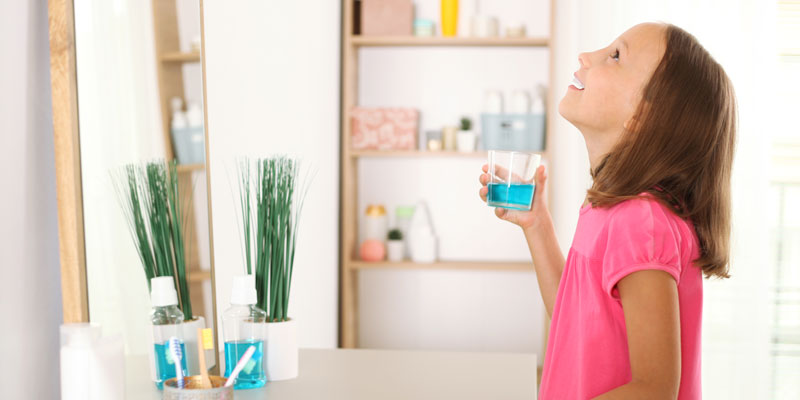Pediatric patients may need to use rinses more than adults
Kristin Goodfellow, RDH, writes about the major benefits of rinsing, and newer mouthrinses like OraCare mouthrinse, that have the same ability to kill bacteria, but without the side effects of traditional mouthrinses like chlorhexidine.

Kristin Goodfellow, RDH, discusses the importance of adding a mouthrinse to hygiene regimens
For both adults and children, brushing and flossing is not enough. Most patients do not do these steps well, and most of the time, they don’t floss at all. Children have limited dexterity and lack of ability to perform these steps, resulting in general poor hygiene and subsequent dental issues. Rinses are a frequently disregarded part of oral hygiene but can have a big impact on kids’ dental health. Recent studies have revealed the major benefits of rinsing which increases the urgency with which we need to recommend rinsing with the normal education of brushing and flossing.
Brushing and flossing obviously is important, but we know that even with years of education, adults still aren’t doing these steps well. If they did, 42.2% of adults at the age of 30 wouldn’t suffer from periodontal disease.1 To truly change this number, prevention has to start in childhood. A recent study by Listerine, which compared using a rinse to traditional flossing, showed that utilizing a rinse is more effective than brushing and flossing alone. “Individuals with lower levels of manual dexterity were shown to benefit from the addition of an essential oil mouthrinse to a regime of tooth brushing and flossing in this clinical trial. The addition of an essential oil mouthrinse improved interproximal gingival health and mitigated the manual dexterity variable.”2 Listerine is an over-the-counter rinse. Professional rinses like OraCare, have the ability to improve gingival health by 604%.3 It has the ability to reduce plaque, bacteria, and bleeding at a higher rate resulting in more effectiveness for patients. Incorporating a rinse at a young age can easily improve dental health and hopefully help young patients adopt better hygiene habits in years to come.
There are a number of factors, like decay, that put children at higher risk. Cavities are a common concern in children, primarily due to poor oral hygiene habits and a diet high in sugary foods and drinks. To truly aid in protecting children from cavities, ideally a layered approach works best. Obviously, trying to reduce sugars in their diet is recommended but can be extremely difficult for parents. I often hear parents saying, “But they don’t even eat a lot of candy,” not realizing that even healthy food choices like milk, fruit, and vegetables break down into sugars in the mouth that can cause decay. In order to help, we have to reduce s.mutans, the bacteria that causes decay. Rinses have the power to kill bacteria better at a higher level than toothpastes alone. A study titled “Antimicrobial Efficacy of Different Toothpastes and Mouthrinses,” found that using a rinse in combination with a triclosan toothpaste provides the highest benefit against s.mutans.4 That study utilized chlorhexidine. If you’re thinking that you’d never recommend chlorhexidine for long term use, because of side effects like staining or additional calculus build-up, I would agree. There are alternatives like OraCare, that have the same ability to kill bacteria, without those side effects, plus better compliance with children because of the better taste.
Controlling bacteria is important for multiple oral issues. For example, gum disease, though less common in children than in adults, can happen, especially if good oral hygiene habits are not taught and maintained. Ultimately, we want to shape their habits early on to improve their oral health. We have to reduce bacterial factors like p.gingivalis in order to reduce the risk of disease. Rinses have the ability to do this, whereas few toothpastes provide this specific benefit. Therefore brushing alone is not going to provide our patients with the ability to circumvent the risks for gum disease. Some rinses work by minimizing the accumulation of bacteria and plaque along the gum line. A study recently conducted using OraCare showed a 255% reduction in plaque better than brushing alone, not only at the gumline but also interproximally.3 By incorporating mouthwash into their daily routine, children and their caregivers can take proactive steps to protect their gums and maintain healthy smiles for years to come.
As dental professionals, we want to recommend the most appropriate products for each patient based on their needs. For kids, there are typically options with vibrant colors and flavors but often the effectiveness can be lacking. We know that bacteria and plaque are major contributors to oral diseases, and this should be a focus of ours to disrupt. Look for products that have the ability to kill bacteria and break up biofilm. By giving the patients your professional recommendation on products, you can instill good habits while also providing them with more effectiveness in their oral hygiene routine to protect their dental health long term.
Mouthwashes are an essential addition to kids’ oral hygiene regimens, providing a host of advantages for their general and dental health. Since brushing and flossing have been proven to not be quite enough, mouthwash can help children to have healthy smiles. It provides extra cleansing power as well as defense against cavities and gum disease. It is our duty as dental experts to inform parents and other caregivers about the value of hygiene and to provide products that are suitable for each child’s specific needs. We can empower kids to take charge of their oral health and enjoy a lifetime of healthy smiles by establishing strong oral hygiene practices early on. The sooner we start the better the long-term outcome.
Kristin Goodfellow, RDH, practices in West Virginia where she has served as a preventative specialist for over 10 years. She completed her dental hygiene degree at Allegany College of Maryland and has also obtained a Bachelor of Arts Degree in Communication from West Virginia University. She is a sought-after speaker who discusses the career paths and professional improvement of dental hygienists. She serves on Cellerant’s Best of Class Hygiene Board and is a Hygiene Liaison for several dental practices in her home state.
Disclosure: Kristin Goodfellow is the Chief Clinical Officer for OraCare, a national dental products company dedicated to increasing the standard of care in dentistry.
- Eke PI, Thornton-Evans GO, Wei L, Borgnakke WS, Dye BA, Genco RJ. Periodontitis in US Adults: National Health and Nutrition Examination Survey 2009-2014. J Am Dent Assoc. 2018 Jul;149(7):576-588.e6.
- Milleman K, Milleman J, Bosma ML, McGuire JA, Sunkara A, DelSasso A, York T, Cecil AM. Role of Manual Dexterity on Mechanical and Chemotherapeutic Oral Hygiene Regimens. J Dent Hyg. 2022 Jun;96(3):35-45.
- Reinhard Schuller. Clinical Efficacy and Safety Evaluation of OraCare Health Rinse in Adults on Plaque and Gingivitis in a Six-Week Model. Reinhard Schuller Consulting. 2023. Available upon request.
- Prasanth M. Antimicrobial efficacy of different toothpastes and mouthrinses: an in vitro study. Dent Res J (Isfahan). 2011 Spring;8(2):85-94.
Besides using Oracare mouthrinse, myofunctional therapy can play a key role for prevention of pediatric conditions. Read Dr. Daniel Klauer’s article in our sister publication, Orthodontic Practice US. https://orthopracticeus.com/myofunctional-therapy-plays-a-key-role-in-the-orthodontic-practice/
